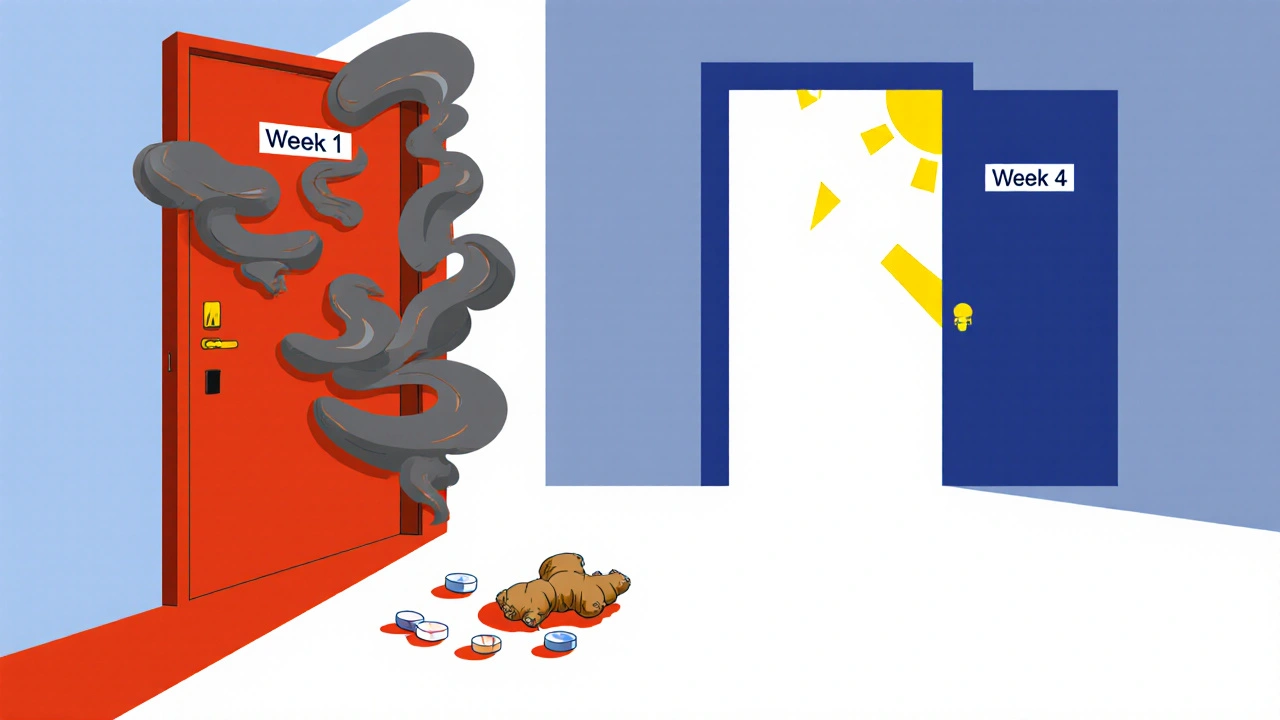Vortioxetine Nausea Resolution Calculator
Based on clinical trial data, nausea from vortioxetine is common but temporary. This tool estimates how long nausea might last for you based on your starting dose.
Expected Nausea Duration
Starting vortioxetine for depression can feel like walking into a storm with no umbrella. You’re hoping for relief from low mood, fatigue, or brain fog - but instead, the first few days bring waves of nausea, sometimes vomiting, and a constant feeling that your stomach is at war with your brain. You’re not alone. About vortioxetine users report nausea within the first week, and for many, it’s the reason they consider quitting before the real benefits even begin.
Why Does Vortioxetine Make You Feel Sick?
Vortioxetine doesn’t just boost serotonin in your brain. It floods your gut with it too. That’s the problem. Serotonin isn’t just a mood chemical - it’s a key player in your digestive system. When vortioxetine blocks serotonin reuptake, more of it hangs around in your intestines, triggering receptors that say, “Hey, something’s off - time to empty the stomach.” Even though vortioxetine blocks some of these receptors (like 5-HT3), the initial surge of serotonin overwhelms the system. This is why nausea hits hardest in the first 3 to 7 days, and why it’s worse if you take it on an empty stomach. It’s not your fault. It’s not “all in your head.” It’s pharmacology - and it’s temporary for most people.How Common Is Nausea With Vortioxetine?
Clinical trials show that about 26% to 30% of people taking vortioxetine get nauseous. That’s nearly 1 in 3. At the lowest dose (5 mg), it’s around 15%. At the standard dose (10 mg), it jumps to 26%. At 20 mg, it hits 29%. Compare that to 8% in people taking a sugar pill - the difference is clear. Nausea isn’t the only gut issue. About 10% to 15% get constipation. 6% to 10% vomit. 5% to 9% get diarrhea. These aren’t rare oddities - they’re expected side effects. But here’s the good news: for 74% of people, nausea fades within two weeks. Only about 6% stop the drug because it doesn’t go away.When Does It Get Better?
Most people don’t realize that the worst of the nausea is over before they even know it. If you’ve made it past day 10 without stopping, your odds of keeping it under control are high. The median time for nausea to resolve is 9 to 16 days, depending on your dose. That’s not a long time - especially when you consider that depression symptoms often start improving around the same window. A lot of people quit before they give it a real shot. One Reddit user wrote: “Threw up twice the first week. Thought I was going crazy. My doctor said stick with it. By day 12, I could eat breakfast again. And for the first time in years, I woke up without dread.” That story isn’t rare. It’s common.How to Reduce Nausea From Day One
You don’t have to suffer through the first week. There are proven, practical steps you can take right now:- Start low. Begin with 5 mg for 7 to 14 days. Then move to 10 mg. This cuts nausea risk by nearly 40% compared to starting at 10 mg. Many doctors skip this step - don’t let them. Ask for it.
- Take it with food. A full meal - not just a cracker - reduces nausea by over 60%. Fat and protein slow absorption, giving your body time to adjust. Avoid greasy or spicy meals, though. They make it worse.
- Try ginger. One gram of ginger daily (in capsule form, tea, or chews) reduces nausea severity by 44%. Ginger works by calming the stomach lining and blocking serotonin receptors in the gut. It’s safe, cheap, and effective.
- Use peppermint. Inhaling peppermint oil or sipping peppermint tea reduces nausea episodes by about 3 per week. It’s not a cure, but it helps when you’re feeling queasy.
- Stay hydrated. Sip water slowly. Don’t chug. Dehydration makes nausea feel worse. Ice chips or frozen fruit pops can help if you can’t keep liquids down.

What If It Doesn’t Go Away?
If nausea sticks around after two weeks, it’s not normal. It’s not just “taking time.” That’s when you need to act. Don’t just wait it out. First, talk to your doctor about over-the-counter options. Dimenhydrinate (Dramamine) works for 78% of people. Take 25 to 50 mg as needed, not daily. It’s not addictive, and it won’t interfere with vortioxetine’s mood effects. If that doesn’t help, ask about ondansetron (Zofran). It’s a prescription drug designed to block nausea signals in the gut. At 4 mg twice a day, it’s 89% effective for vortioxetine-induced nausea. It’s safe for short-term use. Many psychiatrists prescribe it as a bridge while your body adjusts. Avoid prochlorperazine unless everything else fails. It’s stronger, but it can cause drowsiness and muscle stiffness. Only use it if your doctor says so.What to Avoid
Some things make nausea worse - and you might not know it.- Don’t take vortioxetine with fluoxetine or other strong CYP2D6 inhibitors. These drugs slow how your body breaks down vortioxetine. That raises blood levels by 2.4 times - and doubles your nausea risk.
- Avoid alcohol. It irritates your stomach and lowers your tolerance for side effects.
- Don’t switch brands. If you’re on generic vortioxetine, stick with it. Different manufacturers can have slightly different fillers that affect absorption.
- Don’t assume it’s “just anxiety.” Nausea from vortioxetine is physical. It’s not psychosomatic. If you’re told it’s “all in your head,” get a second opinion.
How Vortioxetine Compares to Other Antidepressants
You might be wondering: “Is this worse than SSRIs like sertraline or escitalopram?” At 10 mg, vortioxetine causes about the same nausea as sertraline - 23% vs. 25%. But here’s the trade-off: sertraline causes sexual side effects in over 30% of users. Vortioxetine? Only 14%. Insomnia? 26% with sertraline. 17% with vortioxetine. Compared to duloxetine (an SNRI), nausea rates are similar - but vortioxetine has lower overall dropout rates. People stick with it longer, even with nausea, because the mood and cognitive benefits kick in. The real advantage? Vortioxetine improves thinking skills - memory, focus, decision-making - in ways most antidepressants don’t. If you’ve struggled with brain fog along with depression, this drug might be worth the bump in the road.
Who Should Not Take Vortioxetine?
It’s not for everyone. If you have irritable bowel syndrome (IBS), nausea rates jump to 41%. That’s almost half. If you’ve had severe GI issues before, vortioxetine might not be the best fit. Also, if you’re under 24, there’s a small increased risk of suicidal thoughts - not from nausea, but from the drug itself. That’s why the FDA requires a boxed warning. But for adults over 24, the benefits usually outweigh the risks.What’s Next for Vortioxetine?
Lundbeck is testing a new extended-release version that releases the drug more slowly. In early trials, it cut nausea from 28% down to 17% - without losing effectiveness. That version could be available by 2026. Meanwhile, doctors are starting to use genetic testing to see how fast your body processes vortioxetine. If you’re a slow metabolizer (about 7% of people), you’re more likely to get sick. That test isn’t routine yet - but it’s coming.Real Talk: Is It Worth It?
Yes - if you stick with it. One user on GoodRx wrote: “Nausea was awful for two weeks. I almost quit. But I kept going. By week 4, I was sleeping through the night. I started remembering names. I didn’t cry every morning. Worth every second of nausea.” Another said: “I’ve tried four antidepressants. This is the first one that made me feel like myself again - after the nausea passed.” The data backs this up. Real-world studies show that 68% of people are still taking vortioxetine after 12 months - higher than most SSRIs. Once the nausea fades, adherence improves. If you’re reading this because you’re struggling with nausea, know this: you’re in the hardest part. It’s not forever. It’s not a sign you’re broken. It’s a sign your body is adjusting. And if you get through the first two weeks, you’ve already won half the battle.How long does nausea from vortioxetine last?
For most people, nausea lasts between 9 and 16 days, with symptoms peaking in the first week. About 74% of users report it resolving completely within two weeks. If nausea continues beyond three weeks, talk to your doctor - it may need a different approach.
Can I take ginger with vortioxetine?
Yes. Ginger is safe and effective when taken with vortioxetine. Studies show 1 gram per day (in capsules, tea, or chews) reduces nausea severity by 44%. It works by calming stomach receptors and doesn’t interfere with how vortioxetine affects your brain.
Should I stop vortioxetine if I feel nauseous?
Don’t stop without talking to your doctor. Nausea is common and usually temporary. Stopping too soon means you might miss out on the benefits - improved mood, better focus, and clearer thinking - that often appear after the nausea fades. Try managing it first with food, ginger, and a lower dose.
Does vortioxetine cause more nausea than other antidepressants?
It causes similar nausea to SSRIs like sertraline (around 25%), but less than SNRIs like duloxetine in terms of overall discontinuation. The key difference is that vortioxetine’s nausea is often milder and resolves faster. It also causes fewer sexual side effects and less insomnia than many alternatives.
Can I take OTC nausea meds like Pepto-Bismol with vortioxetine?
Pepto-Bismol (bismuth subsalicylate) is generally safe to use short-term with vortioxetine. However, it doesn’t target the serotonin-driven nausea as directly as dimenhydrinate or ondansetron. If you’re using it regularly, tell your doctor - there are better options for this specific type of nausea.
Is vortioxetine safe for long-term use despite nausea?
Yes. Once the initial nausea passes, most people tolerate vortioxetine well long-term. Real-world data shows 68% of users stay on it after 12 months - higher than many SSRIs. The benefits for mood and cognition often outweigh the early discomfort. Regular check-ins with your doctor ensure it stays safe for you.







Neoma Geoghegan
November 25, 2025 AT 14:41Alex Dubrovin
November 27, 2025 AT 03:01Nikki C
November 28, 2025 AT 16:30Douglas cardoza
November 30, 2025 AT 00:42steven patiño palacio
November 30, 2025 AT 16:16Akash Chopda
December 2, 2025 AT 08:29stephanie Hill
December 4, 2025 AT 01:10Jacob McConaghy
December 5, 2025 AT 16:42Natashia Luu
December 7, 2025 AT 14:02Rachael Gallagher
December 7, 2025 AT 15:08Vineeta Puri
December 9, 2025 AT 03:34Jeff Hicken
December 9, 2025 AT 20:50akhilesh jha
December 10, 2025 AT 19:18Adam Hainsfurther
December 12, 2025 AT 18:43